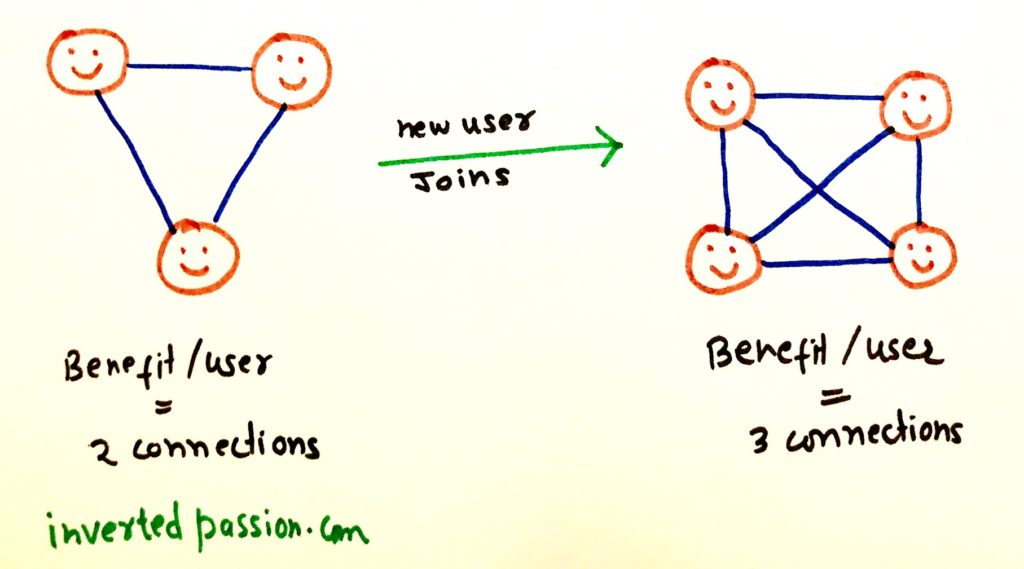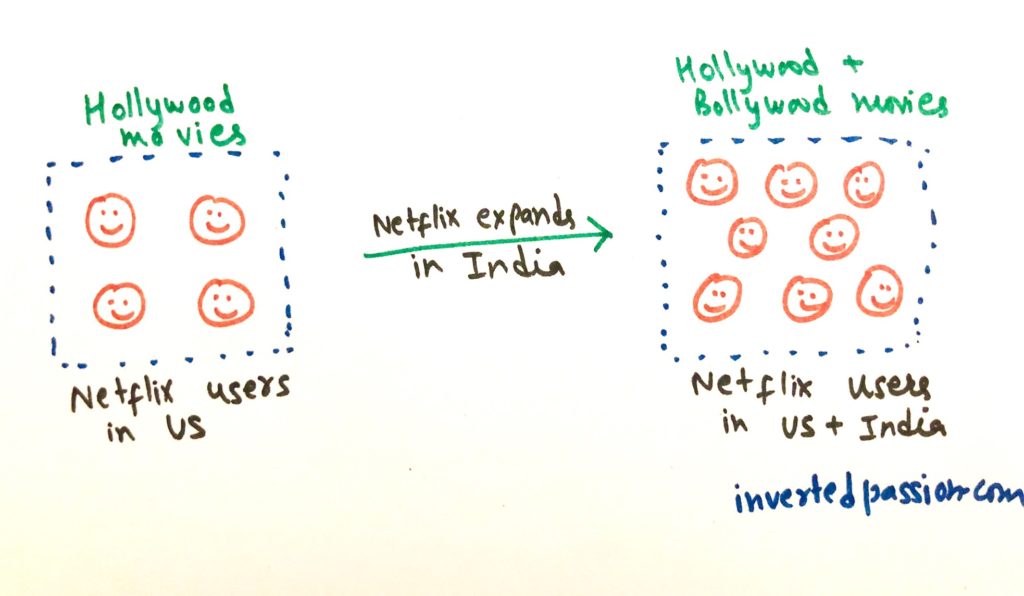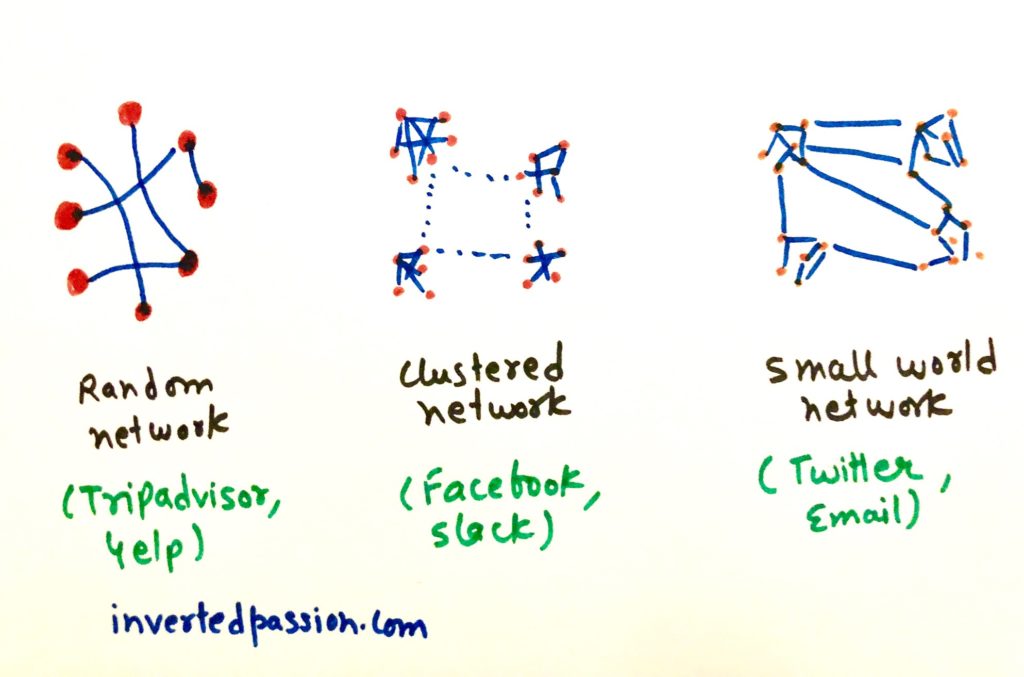The winner-takes-all phenomenon in business is appealing. All entrepreneurs dream of their products being used by everyone in the market. Large tech companies such as Microsoft, Facebook, Uber, Amazon, and Netflix derive their massive valuations by dominating their respective markets. How did they achieve this dominance, and do new startups have a chance against them?
The primary cause of this massive growth of large tech companies in a short period is network effects. Many tech products grow more useful as more users use them, so larger the user base gets the more benefit each user is able to derive. This kicks in a positive feedback cycle whereby the tech product’s value increases exponentially (and becomes hard to dislodge by competitors). This increase in benefits with numbers of users is unprecedented in history. In the non-tech products world, if you use a particular brand of toothpaste, you do not make it more likely for a random stranger to pick up that brand of toothpaste. (Yes, word of mouth exists for non-tech products but that’s about it.)
But for many tech products, as you use them you create all sorts of incentives for other people to join. There are many reasons why technology makes it easier for network effects to come into play:
- Because tech products typically require help and advice, user communities get formed around popular products.
- In B2B, because tech products require implementation, service providers mushroom around such products.
- Replication and distribution cost of software tech products is negligible, so it can be made available to users for free (Facebook, Google, email)
- Tech gives birth to more tech, so this stacking phenomenon creates incentives for developers of new tech to choose existing popular tech
The winner-takes-all phenomenon is popular because it’s an easy to remember phrase but one should be careful in applying everywhere as it’s highly context-dependent. I think this pop advice that only one big network can dominate dissuades many entrepreneurs because they do not go one level deeper into the nature of understanding network effects. These big companies seem invincible and they’re indeed in strong positions, but their strength is what makes studying them important and profitable. The effort v/s reward equation of trying to know makes Uber worth $75Bn is heavily tilted in an entrepreneur’s favor. Most people seem to fall for the hero-founder bias because that’s what news chooses to cover. But not many people try to dig deeper into the structure of markets in which big tech companies operate. If you do that, you’ll gain an edge over other entrepreneurs.
Understanding structures of the environment that leads to success is one of the recurring themes on Inverted Passion. For example, see my earlier article that explained why librarians make more money than scientists. In this article, I’ll unpack network effects and its impact on business growth.
Not all network effects are created equal
In academic literature, two types of network effects are generally identified. One is called indirect network effects and the other is called direct network effects.
Direct network effects
Direct network effects kick in when the increase in value in a product or a service is contributed directly by other users. Products that facilitate communication or interaction between people are said to have direct network effects. Take for example Facebook. You value it because you get to see posts and updates by your friends and family. Other examples of direct network effects are email, WhatsApp, eBay, Uber, AirBnB, and Youtube.

Indirect network effects
Indirect network effects happen when the increase in value in a product or service occurs when each additional user makes it more attractive for non-user entities to make an investment in increasing value of the offering. Platforms are examples of indirect network effects. Take for example Windows or iOS App Store. An increase in a number of users for these platforms makes it lucrative for developers to develop applications for these platforms, which further increases value of these platforms. This kicks in a positive flywheel. Specific examples of indirect network effects include Netflix (they amortize investments in original content), Salesforce (their app store + partner community), Amazon (they attract 3rd party merchants).

Not all network benefits are created equal
The reason why different people take part in different networks has important implications on how fast they grow and how defensible they’re against startups and competitors.
Communication benefit
This is one of the most common uses of a network. Humans want to communicate with one another and if a network allows that, it’s a direct benefit. Facebook, WhatsApp, mobile carriers are examples of networks that provide this benefit.
Economic benefit
If a network facilitates economic transactions (i.e. exposes me to buyers or sellers), users join that network to either make money or to acquire services that they want. Uber, AirBnB, eBay, organizations are examples of this.
Entertainment benefit
If a network gives access to entertainment, users join that network to have fun. Youtube, 9Gag, Twitch, offline parties are examples of this.
Information benefit
If a network exposes useful information, users join it to get access better future opportunities or knowledge. LinkedIn, conferences, Reddit, Hacker News are examples of this.
Not all network structures are created equal
The word ‘network’ generally brings to the mind some sort of (online or offline) social network where you are connected to friends and family. But in a technical sense, a network is a structure where things are connected to one another. This definition is intentionally vague because it leaves many different types of networks to emerge from it. In the real world, networks seldom have a simple structure. So in the scope of this article, let’s discuss three types of networks: a) random network; b) clustered network; c) small-world network.
Random network
A random network is where nodes are connected randomly to each other. Example of this would include review websites (like Tripadvisor forum) or chat websites (like Chatroulette). On these websites, who you are talking to doesn’t typically have a defined pattern. You rather stumble onto your network. One day you could be chatting with one person and another day with someone else.
Clustered network
A clustered (or regular) network is where there are several clusters (of people connected to each other) but very few connections between them. In pre-Internet days, this is what most social networks were like. Limits of geography dictated who you talked and hung out with often (and that was usually close friends, colleagues, and family around your home). Today, instant messengers in office would qualify in this category. At Wingify, teams for our two products VWO and PushCrew use different instant messengers (Skype and Slack respectively) because there is not major overlaps between them (yet). Other examples of technologies that are based on clustered networks would include Facebook (you talk to your friends, mostly) and LinkedIn (you connect to your colleagues, mostly).
Small world network
A small world network is a network structure where there are lots of clusters but there are also connections or bridges between these clusters. You can imagine a small world network to be somewhere in between random and clustered network. It’s clustered but with random connections between clusters. In pre-Internet days, you’d spent most of your time hanging out with the same colleagues and friends, but whenever you went to a party or a conference, you bumped into people that expanded your worldview. In this way, conference or party became your bridge to other clusters. In the tech world, email is an example of small world network (you mostly exchange emails with known people but every now and then have an interaction with a stranger). Another example would be Twitter where you are connected with both people you know and who you don’t know.

B2B products like Salesforce, Zendesk, VWO are also implemented in a small world network. In case of CRM, most of the time, salespeople from the same organization (clusters) use the product and talk about it but every now and then salespeople change jobs and carry their recommendation with them.
Oppurtunities for startups and competition
For a startup, it’s important to know what type of network it’s operating in and what network effects could be possible in that environment. Because these differences in networks exist, we have hundreds of CRMs apart (from Salesforce), tens of enterprise IMs (slack, skype, stride, Microsoft teams), multiple browsers (Chrome, Firefox, Safari), multiple OSes (iOS/Android, Mac/Windows/Linux) but only one dominant professional network (LinkedIn), only one dominant social network (Facebook) and only one dominant video updating website (Youtube).
To understand these differences, let’s explore a few properties of networks and its implications.
Property 1: during early days of the market, a more clustered network allows for competing products to coexist
Distinct clusters make it hard for network effects to quickly travel across the entire network. (Read this paper for details) If there are few connections in the network, what happens in one part of the network has a negligible impact on other parts. This happened in the mobile IM market where different products took hold of different geographies (WeChat in China, WhatsApp in India, Facebook Messenger in US, Line in Japan). The reason these products co-exist is because the use of IM implies that you chat with people you already know. And that’s very geography dependent. A Chinese using WeChat has little or no benefit to an Indian trying to decide which IM to use. Another implication of this property is that initial choice of which cluster to target and the timing matters (read this paper). One major factor in Facebook’s success was targeting US universities only initial years. WhatsApp succeeded because it targeted Indian-diaspora in US to communicate with family free of cost. Clusters matter!
Property 2: as markets get established, technologies established in clustered networks become very hard to dislodge
The slow increase of network benefits in a clustered environment also makes it difficult for a new startup to dislodge an existing incumbent. (Read this paper for details) This means that because WhatsApp has 500+ million users in India, even if a new startup captures 50 million users in a particular cluster (say in one particular state or region), it’s very difficult to dislodge other 450+ million WhatsApp users. This is what happened with SnapChat. It has captured a cluster (US teens) but wasn’t able to dislodge the mainstream Facebook or Instagram users. A good thumb rule to remember is that the more clustered a particular technology’s users are the slower it will grow initially, but once widely adopted, it will go away slowly
However, this doesn’t mean technologies in clustered networks last forever. Populations, competing products, and people’s preferences evolve over time and that makes it likely for a new product with different or enhanced use case to have a chance. But for the new product to appeal, it will have to provide a multi-fold increase in benefit over the existing product (an incremental benefit will not work as people are loss averse, see my earlier article). Even after a multifold increase in benefit from a new product, people continue using both new and old products because of other people in their network change slowly. And that time frame in which existing and new products co-exist gives a chance to existing companies to improve or copy. (This is also what happened when Instagram copied Snapchat stories, or when Facebook acquired WhatsApp).
Property 3: Targeting mass market initially may backfire for new tech products
Since many tech products exhibit network phenomena, it pays to target a well-connected, highly clustered niche initially. Facebook started by targeting just Harvard students (who live in same hostels, go to same clubs), Uber started in San Fransico, Twitter started just in one event (SXSW). This paper has an interesting comparison of two early handheld technologies Momenta and Palm. Momenta spent their bandwidth and marketing dollars in mass-market campaigns while Palm focused on just the Silicon Valley crowd. Because of narrow focus, Palm was able to create specific apps for their initial users and convince other third-party developers to create apps that specifically appealed to their initial users. Also a narrow geographic region where people bump into each other also meant people saw many others like them talking and using Palm. For late adopters, it’s important to see that everyone else they know is using the product. After they got entrenched in Silicon Valley, Palm expanded to a much bigger audience in US and worldwide. On the other hand, imagine as an early user of Momenta, you see a random bunch of apps and nobody around you using it. It just fizzeled out early.
Property 4: Nature of benefits that a network provides determines the behavior of people in it
People’s preferences for different types of benefits is different. We are typically much more serious about making money than getting entertained. The level of investment we’re willing to make (in terms of money, effort, time) for getting different benefits is also different (see my earlier post on why you shouldn’t set prices based on value created). This has interesting implications for user loyalty within a network and existence of competing networks.
When someone’s livelihood depends on a network (like for Uber drivers, Youtube creators, AirBnb hosts or eBay sellers), such networks become extremely important for these users and they invest a lot of time and investment into them. So unless a competing service offers guaranteed livelihood, these users do not defect the network. Same is true for communication networks. We value talking to our friends and family a lot, so a competing service has to be extremely better for us to try it. This makes networks that give communication or economic benefit extremely valuable.
However, for networks that give entertainment benefit, people find it easy to jump from one network to another because beyond these networks they have multiple sources of entertainment (games, movies, books). That’s why the number of information or entertainment networks is high but user loyalty on these networks is less as compared to communication or economic networks.
Prediction time
Because there are many ways for things to go wrong than to go right, predictions about social systems should always be made with an assumption that they’ll turn out to be false (here’s the detailed reason). But it’s worthwhile to predict. At the minimum, if you go wrong, it’ll allow you to expand and enrich the model to incorporate new, unforeseen factors. At best, you can make a profit or claim I-told-you-so. (Just please don’t bet your life’s savings on predictions)
So with that caveat, with respect to networks, let’s have some fun making a few predictions.
Will Snapchat, the product, survive in 2018? Yes. It’ll not grow, but it’ll survive for now because clusters of US teens who use the product don’t overlap much with other clusters (as far as informal, friendly communication is concerned). The danger is in teens maturing to be adults and some other product (say a variant of Instagram or a startup) capturing kids who’ve newly become teens.
Will bitcoin gain or lose in 2018? At this point, bitcoin is primarily used as a store of value (and not as a token of exchange). As a store of value, it should track inflation in the long run and price should stabilize at some point (just like gold). Right now, there’s a rush where bitcoin is being used for making profits. In 2018, it looks like the price should go still higher because many people have a vested interest in keeping the price going up. Other people want to buy because it’s going up. Ultimately, after the bubble bursts, the price should stabilize in future. Whether it’ll happen this year is anyone’s guess.
Will there be a major new Facebook competitor in 2018? It’s quite likely (but whether it happens in 2018 or 2019 is hard to say). People are recognizing increasingly negative effects of Facebook (anxiety, privacy issues, clutter). This does leave an opening for a new network to come along. Why isn’t that network Instagram? Because Instagram is from the same company with similar values. This new non-Facebook network will first appeal to smaller but passionate clusters who feel the highest amount of pain from Facebook, and slowly spread to other clusters. In that time Facebook will try to buy or clone it. This new network could possibly start in Europe where cries about privacy are the loudest.
Your favorite examples of network effects
Now that you’ve read the article, I have a question for you.
What's your favorite example of network effects (in either tech or non-tech context)?
I'll RT interesting examples.
— Paras Chopra (@paraschopra) January 3, 2018
What are your favorite examples of network effects? Tweet your response to me as a reply to this thread and I’ll retweet the most interesting examples. In the same thread, you can also check out and comment on what others proposed.
Join 200k followers
Follow @paraschopra